|
|
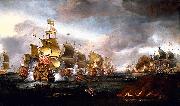 |
Adriaen Van Diest
|
|
was born at the Hague in 1655. He was the son of Jeronymus van Diest, a painter of sea-pieces, by whom he was instructed in the art. When he was seventeen years of age he came to London, and was employed by Granville, Earl of Bath, for whom he painted several views and ruins in the west of England. He also painted portraits, but did not meet with much encouragement, although his pictures, particularly his landscapes, possess considerable merit; as a proof of which Horace Walpole states that there were seven pictures by Van Diest in Sir Peter Lely's collection. He etched several landscapes from his own designs, in a slight, masterly style. Van Diest died in London in 1704. Unfortunately for his reputation, he is generally known by his worst pictures, which are frequently found in old houses, on wainscots, or over doors, and are executed in a hasty manner, with much mountainous background. His better pictures have changed their name.
|
|
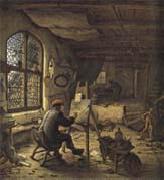 |
Adriaen van ostade
|
|
Dutch Baroque Era Painter, 1610-1685
Painter, draughtsman and etcher. According to Houbraken's rather unreliable biography, he was a pupil concurrently with Adriaen Brouwer of Frans Hals in Haarlem. Hals influenced him very little, whereas Brouwer, who was described as 'known far and wide' as early as 1627, had a decisive influence on the evolution of Adriaen van Ostade's always idiosyncratic portrayal of peasant life. The first documentary mention of Adriaen van Ostade as a painter is in 1632 (Schnackenburg, 1970). Most of his paintings are signed and dated, the earliest firmly dated example being the Peasants Playing Cards |
|
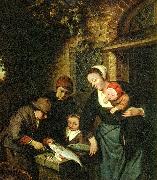 |
adriaen van ostade
|
|
Adriaen van Ostade (baptized as Adriaen Hendricx December 10, 1610 ?C buried May 2, 1685) was a Dutch genre painter.
He was the eldest son of Jan Hendricx Ostade, a weaver from the town of Ostade near Eindhoven. Although Adriaen and his brother Isaack were born in Haarlem, they adopted the name "van Ostade" as painters.
"Peasants in a Tavern" (c. 1635), at the Alte Pinakothek, MunichAccording to Jacobus Houbraken, he was taught from 1627 by Frans Hals, at that time the master of Adriaen Brouwer and Jan Miense Molenaer. At twenty-six he joined a company of the civic guard at Haarlem, and at twenty-eight he married. His wife died in 1640, and he speedily re-married. He again became a widower in 1666. In 1662 he took the highest honors of his profession with the presidency of the painters Guild of Saint Luke in Haarlem. Among the treasures of the Louvre is a striking picture of a father sitting in state, his wife at his side, surrounded by his son, five daughters, and a young married couple in a handsomely furnished room. By an old tradition, Ostade here painted himself and his children in holiday attire; but the style is much too refined for the painter of boors, and Ostade had but one daughter. |
|
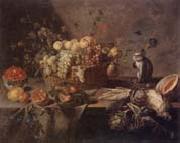 |
Adriaen Van Utrecht
|
|
Flemish Baroque Era Painter, 1599-1652
Flemish painter. He was apprenticed to Herman de Ryt in 1614 and later visited France, Italy and Germany before returning to Antwerp by 1625. He painted pantry scenes, farmyards with poultry, fish markets, game pieces, garlands and diverse still-lifes of fruit and vegetables. Game paintings are most frequent and reflect the influence of Frans Snyders. Adriaen adopted the same abundant displays of game, fruit and vegetables, usually set on a table parallel to the picture plane. Compositions typically fall in horizontal and vertical lines in contrast to the dynamic diagonals of Snyders. In large works, such as the Still-life with Game, Vegetables, Fruit and a Cockatoo (1650; Malibu, CA, Getty Mus.), Adriaen's accessories overflow the table on to the floor below. Baroque devices, such as a sweeping curtain and background window view, add movement and depth. Van Utrecht favoured warm earthen tones, especially grey-green, and a strong chiaroscuro light in his still-lifes; the latter may derive from his knowledge of Italian painting. The artist's style changed little during his career, save for the gradual elimination of figures in his paintings. The influence of Jan de Heem and Jan Fyt can also be seen in his later work. |
|
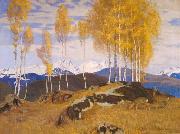 |
Adrian Scott Stokes
|
|
RA (1854-1935) was an English landscape painter. Born in Southport, Lancashire, he became a cotton broker in Liverpool, where his artistic talent was noticed by John Herbert RA, who advised him to submit his drawings to the Royal Academy. He entered the Royal Academy Schools in 1872 and exhibited at the Academy from 1876. In that year went to France where he lived for 10 years, settling back in England in 1886, at Carbis Bay and joining the artists' colony at St Ives.
Adrian Stokes was a landscape painter, concerned most with atmospheric effects, and later with decorative landscapes. He was the author of 'Landscape Painting' (1925). He became ARA in 1909 and RA in 1919, won medals at the Paris Exhibition and Chicago World Fair (1889), became first President of the St Ives Society of Arts (1890) and Vice President of the Royal Watercolour Society (1932).
He married Marianne Preindlesberger of Graz, Austria, in 1884, while living in France. She became a well known artist under her married name of Marianne Stokes. An obituary of Adrian Stokes was published in The Times Monday 2 December 1935
|
|
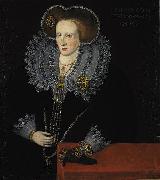 |
Adrian Vanson
|
|
Adrian Vanson (died c. 1602) was court portrait painter to James VI of Scotland.
Adrian succeeded Arnold Bronckorst as court painter in Scotland in May 1584, and his appointment was subsequently confirmed by royal letter on 20 August 1584. Adrian Vanson was paid £8-10s in June 1581 for two pictures sent to Theodore Beza. A letter by James VI's former tutor Peter Young accompanied pictures of John Knox and George Buchanan sent to Geneva in November 1579 for the woodcuts in Beza's Icones (1580). The Scottish portraits arrived too late for the book, and the woodcuts of Knox and a James VI, thought to be by Vanson, were first published in Simon Goulart's edition of the Icones in 1581. The picture of George Buchanan, which was never published in Beza's Icones, but may have appeared in other later works, is attributed to Bronckorst.
Knox from Beza's Icones,
after Adrian VansonVanson also painted ceremonial spears and banners for the coronation of Anne of Denmark. When he was made a burgess of Edinburgh, it was hoped he would teach his craft to apprentices. He may have been 'Lord Seton's painter', who was recorded drawing portraits for coins at the mint in Edinburgh. There was a un-named Flemish painter working on the king's portrait at Stirling Castle in May 1579. This may have been Vanson or Bronckorst. According to the inventories of the Earl of Leicester, he had a portrait of the 'young king of Scots' in 1580, which may have been another copy of this picture. Leicester sent his own portrait to James VI, painted on canvas by Hubbard in 1583.
Attributed portraits include James VI; Anne of Denmark; Patrick Lyon, Lord Glamis; Sir Thomas Kennedy of Culzean; Agnes Douglas, Countess of Argyll. Vanson's James VI of circa 1585 survives at Edinburgh castle. In May 1586 a French ambassador in Scotland, the Baron d'Esneval, promised to get Mary, Queen of Scots a copy of a recent portrait of James VI from the only painter in Edinburgh. There had been rumours of an embassy to Denmark to discuss the king's marriage in April 1586. It is thought the picture at Edinburgh Castle was made by Vanson for this embassy or a similar purpose. |
|
|
|
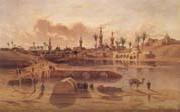 |
Adrien Dauzats
|
|
French Academic Painter, 1804-1868,French painter, illustrator and writer. His early training was as a theatrical scene painter and a designer of lithographic illustrations. In Bordeaux he studied with Pierre Lacour (ii) (1778-1859) and worked with Thomas Olivier (1772-1839), chief scene designer at the Grand-Thetre. He subsequently studied in Paris in the studio of the landscape and history painter Julien-Michel Gue (1789-1843) and worked for the decorators of the Thetre Italien. |
|
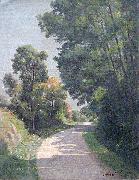 |
Adrien Lavieille
|
|
(March 29, 1848, Montmartre - February 5, 1920, Chartres) was a French painter.
Portrait of Adrien Lavieille in 1879, by his wife, Marie Adrien Lavieille.
Oil on canvas (private collection).Son of the landscape painter Eugene Lavieille, and nephew of the wood engraver Jacques Adrien Lavieille, he was a painter of the country : near Paris, in Brittany, near Cancale and on the riverside of the Vilaine in the south of Rennes, in Touraine, at Saint-Jean-de-Monts in Vendee, where he was invited by a friend, the painter and engraver Auguste Lepere, around Vendôme where he sojourned in the home of his daughter, Andree Lavieille, so a painter, and of his son-in-law, the man of letters, Paul Tuffrau.
He also painted in Montmartre, where he lived during his youthful days, and, as his father, at Moret-sur-Loing, near Fontainebleau.
Parallelly to his painter's activities, Adrien Lavieille executed, during his life, for money's reasons, works of restoration and decoration : basilica Saint-Martin in Tours (where he worked with the painter Pierre Fritel), Palais de Justice of Rennes, Château de Vaux-le-Vicomte, Hôtel de Lauzun, quai d'Anjou in Paris.
In 1878, he married the painter Marie Petit. |
|
|
|
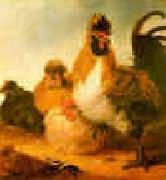 |
Aelbert Cuyp
|
|
1620-1691
Dutch
Aelbert Cuyp Locations
Painter and draughtsman, son of Jacob Cuyp. One of the most important landscape painters of 17th-century Netherlands, he combined a wide range of sources and influences, most notably in the application of lighting effects derived from Italianate painting to typical Dutch subjects. Such traditional themes as townscapes, winter scenes, cattle pieces and equestrian portraits were stylistically transformed and given new grandeur. Aelbert was virtually unknown outside his native town, and his influence in the 17th century was negligible. He became popular in the late 18th century, especially in England. |
|
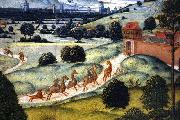 |
Aelbrecht Bouts
|
|
( 1450s, Leuven - March 1549, Leuven) was a Netherlandish painter. His first name is sometimes spelled eAlberte, eAelberte or eAlbrechte. He was born into a family of painters. Aelbrechtes father was Dieric Bouts the Elder (ca.1415-1475), and his brother was Dieric Bouts the Younger (ca.1448-1490). Jan Bouts (ca.1478-ca. 1530), son of Dieric Bouts the Younger, also became a painter. Dieric Bouts the Younger inherited his fatheres shop in 1475, while Aelbrecht established his own workshop, also in Leuven. Whereas Dieric the Younger continued in his father's style, Aelbrecht developed his own unmistakable style with strong colors, rich texture and fine details.
Bob Jones University Museum and Gallery (Greenville, South Carolina), the Cleveland Museum of Art, the Fitzwilliam Museum (Cambridge), Harvard University Art Museums, The Honolulu Academy of Arts, the Hood Museum of Art (Hanover, New Hampshire), the Norton Simon Museum (Pasadena, California), the Royal Museums of Fine Arts of Belgium, the Czartoryski Museum and the Staatsgalerie Stuttgart are among the public collections having paintings by Aelbrecht Bouts.
|
|
 |
Aelst, Willem van
|
|
Dutch Baroque Era Painter, 1627-ca.1683 Studied under Otto Marseus van Schrieck. Students included Rachel Ruysch. Specializes in Still Life. was a Dutch artist who specialized in still-life painting with flowers or game. Van Aelst was born to a family of prominent city magistrates. He learned to paint from his uncle, the still-life painter Evert van Aelst. On 9 November 1643 he enrolled as a master of the Guild of Saint Luke at Delft. Between 1645 and 1649 he lived in France. In 1649 Van Aelst travelled to Florence, where he served as court painter to Ferdinand II de Medici, grand duke of Tuscany. At this time, the grand duke also employed two fellow Dutchmen Matthias Withoos and Otto Marseus van Schrieck, the latter also a still-life painter who probably influenced Van Aelst's style. In 1656 he returned to the Netherlands to settle permanently in Amsterdam. He became one of the most prominent still-life painters of his generation, |
|
|
|
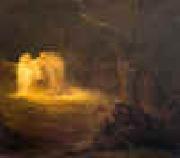 |
Aert de Gelder
|
|
Dutch
1645-1727
Dutch painter and draughtsman. He was the son of a wealthy Dordrecht family and probably became a pupil of Samuel van Hoogstraten in 1660. Apparently on the advice of van Hoogstraten, de Gelder moved to Amsterdam and entered Rembrandt workshop, possibly c. 1661. It is commonly assumed that he stayed there about two years. He was Rembrandt last pupil. After completing his apprenticeship, de Gelder returned to Dordrecht, where he worked for the rest of his long career. Considering that de Gelder was active for more than half a century, his output of just over 100 paintings seems low, probably because he was financially independent. Of those paintings accepted as by him, only 22 are dated, creating considerable problems in establishing a chronology.
|
|
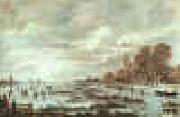 |
Aert van der Neer
|
|
1603-1677
Dutch
Although generally known by the name of Aert, he usually signed himself Aernout. According to Houbraken, van der Neer spent his youth in Arkel near Gorinchem (Gorkum), a town on the river Waal, east of Dordrecht, where he worked as a majoor (steward) for the lords of Arkel. He became an amateur painter, possibly as a result of his contact with the Camphuyzen brothers Rafael Govertsz. (1597/8-1657) and Jochem Govertsz. (1601/2-59). Aert married Lysbeth Govertsdr (Liedtke) who was almost certainly Rafael and Jochem sister. Rafael acted as witness at the baptism of their daughter Cornelia in 1642. Around 1632 van der Neer and his wife moved to Amsterdam where, in about 1634, their eldest son, Eglon, was born. |
|
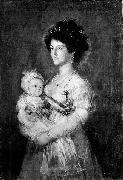 |
After Francisco de Goya
|
|
Francisco Jose de Goya y Lucientes (30 March 1746 - 16 April 1828) was a Spanish romantic painter and printmaker regarded both as the last of the Old Masters and the first of the moderns. Goya was a court painter to the Spanish Crown, and through his works was both a commentator on and chronicler of his era. The subversive and imaginative element in his art, as well as his bold handling of paint, provided a model for the work of later generations of artists, notably Manet, Picasso and Francis Bacon.
|
|
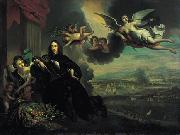 |
After Jan de Baen
|
|
Jan de Baen (20 February 1633 - 1702) was a Dutch portrait painter who lived during the Dutch Golden Age. He was a pupil of the painter Jacob Adriaensz Backer in Amsterdam from 1645 to 1648. He worked for Charles II of England in his Dutch exile, and from 1660 until his death he lived and worked in The Hague. His portraits were popular in his day, and he painted the most distinguished people of his time. |
|
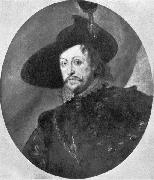 |
After Peter Paul Rubens
|
|
Sir Peter Paul Rubens (Dutch pronunciation: [ˈrybə(n)s]; 28 June 1577 - 30 May 1640), was a Flemish Baroque painter, and a proponent of an extravagant Baroque style that emphasised movement, colour, and sensuality. He is well-known for his Counter-Reformation altarpieces, portraits, landscapes, and history paintings of mythological and allegorical subjects.
In addition to running a large studio in Antwerp that produced paintings popular with nobility and art collectors throughout Europe, Rubens was a classically educated humanist scholar, art collector, and diplomat who was knighted by both Philip IV, King of Spain, and Charles I, King of England.
|
|
 |
Agasse, Jacques-Laurent
|
|
Swiss Painter, 1767-1849 Specializes in AnimalsEnglish painter of Swiss birth. Born into a wealthy and politically influential Huguenot family, Agasse spent his early childhood at the country estate of Cr?vin, where he may have developed the interest in animals and natural history that was to guide his later career as an artist in England. Agasse trained first at the Ecole du Colibri in Geneva and subsequently in Paris under Jacques-Louis David (beginning in 1787) and possibly under Horace Vernet. His early artistic output consisted chiefly of unpretentious silhouette 'cut-outs' in the style of Jean-Daniel Huber. |
|
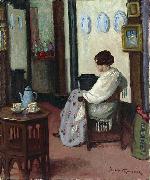 |
Agnes Goodsir
|
|
(18 June 1864, Portland, Victoria - 1939, France) was an Australian portrait painter who moved within lesbian circles in Paris in the 1920s and 1930s.
Goodsir was one of eleven children born to David James Cook Goodsir, Commissioner of Customs at Melbourne, and Elizabeth Archer.
Her early art training started with Arthur T. Woodward at the Bendigo School of Mines in the 1890s, and in 1899 some of her work was raffled in Bendigo to partly finance her study in Paris. The years following World War I saw a virtual exodus of Australian artists on a sort of Grand Tour to Paris, all intent on being part of the explosion of the arts taking place there. Painters like Rupert Bunny, Stella Bowen and Max Meldrum were drawn there by the appeal of the Left Bank. Others like Margaret Preston and Grace Crowley were inspired to develop in new directions by post-war Parisian art.
Goodsir attended the Academie Delecluse, the Academie Julian and then the Academie Colarossi. From about 1912 she shuttled between London and Paris, but finally settled in Paris at 18 Rue de l'Odeon. Her constant companion was Rachel Dunn, depicted in several of her paintings, such as The Chinese Skirt 1933, Girl with Cigarette 1925, The Letter 1926 and Morning Tea 1925.
Her work was acclaimed and exhibited at the New Salon, the Salon des Independants, and the Societe Nationale des Beaux Arts in Paris as well as at the Royal Academy and the Royal Institute in London. On a short visit to Australia in 1927 she exhibited at the Macquarie Galleries in Sydney and the Fine Arts Gallery in Melbourne. In 1938 four of her oils were shown at the sesquicentennial exhibition at the NSW National Art Gallery.
On her death in 1939, her paintings were left to her companion Rachel Dunn, who sent some 40 to Agnes's family in Australia and others to Australian galleries. |
|
 |
Agnolo Gaddi
|
|
Italian Early Renaissance Painter, ca.1345-1396
Son of Taddeo Gaddi. Through both his brother Giovanni and his father, Agnolo was heir to the Giottesque tradition and to a successful family enterprise, which he directed with enormous success up to the turn of the 15th century. He is first mentioned as a painter in 1369, when he assisted his brother Giovanni and Giovanni da Milano in decorations for Urban V (reg 1362-70) in the Vatican. Although he probably did not assume full responsibility for the workshop until his brother Giovanni death, he must have begun accepting his own commissions as early as the 1370s. The nature of his early work and whether it included an altarpiece dated 1375 (Parma, G.N., 435), however, remains a matter of debate. Logical or likely though it may be, the notion that this early activity developed out of his brother Giovanni still little-known art is hypothetical. Whereas the works grouped around Giovanni name are all small panels, Agnolo was an artist who, like his father, excelled in wall painting. Indeed, three monumental fresco cycles (see below), in the Castellani Chapel (painted c. 1384) and the choir (painted c. 1388-93) of Santa Croce, Florence, and the chapel of the Sacra Cintola (doc. 1393-5) in Prato Cathedral, constitute the artist most notable surviving works and offer a basis for reconstructing the content and chronology of his oeuvre. |
|
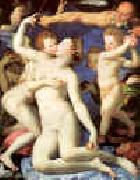 |
Agnolo Bronzino
|
|
Italian Mannerist Painter, 1503-1572
Agnolo di Cosimo (November 17, 1503 ?C November 23,1572), usually known as Il Bronzino, or Agnolo Bronzino (mistaken attempts also have been made in the past to assert his name was Agnolo Tori and even Angelo (Agnolo) Allori), was an Italian Mannerist painter from Florence. The origin of his nickname, Bronzino is unknown, but could derive from his dark complexion, or from that he gave many of his portrait subjects. It has been claimed by some that he had dark skin as a symptom of Addison disease, a condition which affects the adrenal glands and often causes excessive pigmentation of the skin. |
|
 |
Agnolo Gaddi
|
|
Italian Early Renaissance Painter, ca.1345-1396 |
|
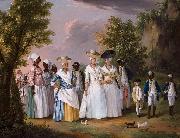 |
Agostino Brunias
|
|
Agostino Brunias (c. 1730 - April 2, 1796) was a London-based Italian painter from Rome. Strongly associated with West Indian art, he left England at the height of his career to chronicle Dominica and the neighboring islands of the West Indies. Painted in the tradition of verite ethnographique, his art was as escapist as it was romantic.
Brunias was born in Rome c. 1730; the exact date is uncertain. His first name has been spelled in various ways including Abraham, Alexander, August, or Austin, while his surname has been recorded as Brunais and Brunyas. Brunias was a student at the Accademia di San Luca, Rome, where he won Third Prize in the Second Class for painting in 1754. An early oil painting of his was exhibited in Rome two years earlier. |
|
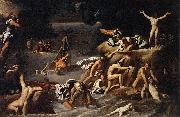 |
Agostino Carracci
|
|
(16 August 1557 ?C 22 March 1602) was an Italian painter and printmaker. He was the brother of the more famous Annibale and cousin of Lodovico Carracci.
He posited the ideal in nature, and was the founder of the competing school to the more gritty (for lack of a better term) view of nature as expressed by Caravaggio. He was one of the founders of the Accademia degli Incamminati along with his brother, Annibale Carracci, and cousin, Ludovico Carracci. The academy helped propel painters of the School of Bologna to prominence.
Agostino Carracci was born in Bologna, and trained at the workshop of the architect Domenico Tibaldi. Starting from 1574 he worked as a reproductive engraver, copying works of 16th century masters such as Federico Barocci, Tintoretto, Antonio Campi, Veronese and Correggio. He also produced some original prints, including two etchings.
He travelled to Venice (1582, 1587?C1589) and Parma (1586?C1587). Together with Annibale and Ludovico he worked in Bologna on the fresco cycles in Palazzo Fava (Histories of Jason and Medea, 1584) and Palazzo Magnani (Histories of Romulus, 1590?C1592). In 1592 he also painted the Communion of St. Jerome, now in the Pinacoteca di Bologna and considered his masterwork. From 1586 is his altarpiece of the Madonna with Child and Saints, in the National Gallery of Parma.
In 1598 Carracci joined his brother Annibale in Rome, to collaborate on the decoration of the Gallery in Palazzo Farnese. From 1598?C1600 is a triple Portrait, now in Naples, an example of genre painting.
In 1600 he was called to Parma by Duke Ranuccio I Farnese to began the decoration of the Palazzo del Giardino, but he died before it was finished.
Agostino's son Antonio Carracci was also a painter, and attempted to compete with his father's Academy.
|
|
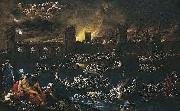 |
Agostino Tassi
|
|
(1578--1644) was an Italian painter, mostly of landscapes and seascapes.
Because he aspired to nobility he modified the details of his early life. Though he was born in Perugia he claimed to have been born in Rome. His family name was Buonamici, but Agostino adopted the surname Tassi to give substance to his story that he was adopted by the Marchese Tassi. He was actually the son of a furrier named Domenico. |
|
|
|
|
|
|
|
|
|
|
|
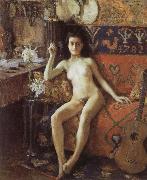 |
Akseli Gallen-Kallela
|
|
April 26, 1865 C March 7, 1931)
Gallen-Kallela was a Finnish artist and designer closely associated with notions of National Romanticism, especially relating to the region of Karelia, also a source of inspiration for the Finnish composer Jean Sibelius. Of particular influence was the collection of folk poems formed in the middle of the 19th century by Elias Lonrot. Following a national competition in 1891 Gallen-Kallela illustrated this national epic known as the Kaleval, the vivid images of which soon became widely known throughout Finland. He also made a significant contribution to the Finnish Pavilion at the Paris Exposition Universelle of 1900 in which he painted frescoes on Kalevala themes in the main dome, as well as designing textiles and furniture. His furniture designs were made by the Iris company, founded by a close friend, Louis Sparre. Like many other ventures associated with Arts and Crafts, the Iris company was concerned with the production of well-designed, well-made furniture and ceramics. Gallen-Kallela designs at Paris 1900 attracted considerable attention leading to the award of a number of Gold and Silver Medals at the exhibition. He worked in a wide range of design media, including ryiji rugs, which he modernized using geometric motifs derived from the Finnish landscape. His distinctive contribution to Finnish culture is preserved in the Gallen-Kallela Museum, which was originally built by him as a studio and family home between 1911 and 1913 and now contains a large body of his work, including paintings, graphics, textiles, jewellery, stained glass, and architectural designs.
|
|
 |
Albani Francesco
|
|
Italian, 1578-1660
Italian painter and draughtsman. He was a distinguished artist of the Bolognese school, deeply influenced by Annibale Carracci's classicism, who worked in Rome as well as Bologna, painting altarpieces, frescoes and and cabinet pictures. His fame rests on his idyllic landscapes and small mythological pictures, |
|
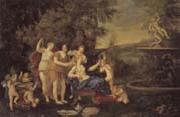 |
Albani Francesco
|
|
Italian Baroque Era Painter, 1578-1660
Italian painter and draughtsman. He was a distinguished artist of the Bolognese school, deeply influenced by Annibale Carracci's classicism, who worked in Rome as well as Bologna, painting altarpieces, frescoes and and cabinet pictures. His fame rests on his idyllic landscapes and small mythological pictures, |
|
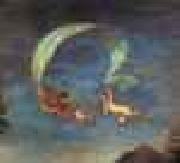 |
Albani, Francesco
|
|
Italian Baroque Era Painter, 1578-1660 Albani's students included Pier Francesco Mola and Andrea Sacchi. Italian painter and draughtsman. He was a distinguished artist of the Bolognese school, deeply influenced by Annibale Carracci's classicism, who worked in Rome as well as Bologna, painting altarpieces, frescoes and and cabinet pictures. His fame rests on his idyllic landscapes and small mythological pictures, |
|
|
|
 |
Albert Anker
|
|
1831-1910
Swiss Albert Anker Galleries
During his studies, Anker produced a series of works with historical and biblical themes, including paintings of Luther and Calvin. Soon after returning to Ins, though, he turned to what would become his signature theme: the everyday life of people in rural communities. His paintings depict his fellow citizens in an unpretentious and plain manner, without idealising country life, but also without the critical examination of social conditions that can be found in the works of contemporaries such as Daumier, Courbet or Millet. Although Anker did paint occasional scenes with a social significance, such as visits by usurers or charlatans to the village, his affirmative and idealistic Christian world-view did not include an inclination to issue any sort of overt challenge.
Also prominent in Anker's work are the more than 30 still lifes he created. They depict both rural and urban table settings in the tradition of Chardin, their realist solidity reflecting Anker's vision of a harmonic and stable world order. In addition, Anker created hundreds of commissioned watercolours and drawings, mostly portraits and illustrations, including for an edition of Jeremias Gotthelf's collected works. To provide for a steady income, Anker also decorated more than 500 faience plates for the Alsatian producer Theodore Deck.
Anker was quick to reach his artistic objectives and never strayed from his chosen path. His works, though, exude a sense of conciliation and understanding as well as a calm trust in Swiss democracy; they are executed with great skill, providing brilliance to everyday scenes through subtle choices in colouring and lighting. Their parochial motives belie the open-mindedness towards contemporary European art and events that Anker's correspondence reflects. |
|
|
|
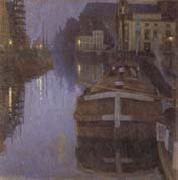 |
Albert Baertsoen
|
|
Belgian, 1866-1922.Belgian painter and etcher. The son of a successful mill-owner and an excellent musician, he was a pupil and friend of Gustave Den Duyts (1850-97), and later, at the Ghent Acad?mie, of Jean Delvin (1853-1922). He was involved in the exhibiting society LEssor in Brussels as well as the triennial salons held in Brussels, Antwerp and Ghent in rotation. Among his earliest important works are The Scheldt at Dendermonde (1887; Ghent, Mus. S. Kst.), which he painted beside Isidore Meyers (1836-1917) and Franz Courtens in a Realist style characteristic of the Dendermonde school. In 1889-90 he attended the studio of Alfred Roll in Paris, where he met Jacques-Emile Blanche and Charles Cottet, and became particularly closely associated with Frits Thaulow, Emile-Ren? M?nard and Edmond Aman-Jean. He exhibited regularly at the Salon in Paris. Although Baertsoen is considered to be one of the first Belgian Impressionists, he belonged to no particular school. He was more than a descriptive landscape painter, for he sought to evoke through the depiction of the natural world a mood of melancholy and resignation. He painted silent streets, rocks, rivers and canals in Bruges, Li?ge, Nieuwpoort, Diksmuide and in London, where he stayed during World War I. His most important paintings, however, were inspired by his native town, Ghent, of which he built up a remarkable portrait over the years in such works as Barges in the Snow (1901) and Ghent in the Evening (1903; both Brussels, Mus. A. Mod.). A broad, spontaneous technique, great delicacy of nuance, deep sincerity as well as a certain meditative quality characterize his work, which is limited in quantity. Baertsoen played an important role in Belgian cultural life of his period and was elected to the Acad?mie Royale des Beaux-Arts in 1919. |
|
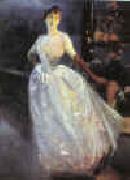 |
Albert Besnard
|
|
1849-1934
French
Albert Besnard Art Locations
(b Paris, 2 June 1849; d Paris, 4 Dec 1936). French painter, printmaker and designer. He was born to an artistic family and was precociously talented. In 1866 he entered the Ecole des Beaux-Arts, where he studied under Jean Franois Brmond (1807-68) and Alexandre Cabanel. His Salon dbut in 1868 and his subsequent entries were well received, and in 1874 he won the Prix de Rome with the Death of Timophanes, Tyrant of Corinth (Paris, Ecole N. Sup. B.-A.). Remaining in Italy for five years, Besnard worked in an academic style influenced by Pietro da Cortona and Michelangelo. |
|
|
|
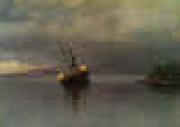 |
Albert Bierstadt
|
|
German-born American Hudson River School Painter, 1830-1902
Bierstadt was born in Solingen, Germany. His family moved to New Bedford, Massachusetts, in 1833. He studied painting with the members of the D??sseldorf School in D??sseldorf, Germany from 1853 to 1857. He taught drawing and painting briefly before devoting himself to painting.
Bierstadt began making paintings in New England and upstate New York. In 1859, he traveled westward in the company of a Land Surveyor for the U.S. government, returning with sketches that would result in numerous finished paintings. In 1863 he returned west again, in the company of the author Fitz Hugh Ludlow, whose wife he would later marry. He continued to visit the American West throughout his career.
Though his paintings sold for princely sums, Bierstadt was not held in particularly high esteem by critics of his day. His use of uncommonly large canvases was thought to be an egotistical indulgence, as his paintings would invariably dwarf those of his contemporaries when they were displayed together. The romanticism evident in his choices of subject and in his use of light was felt to be excessive by contemporary critics. His paintings emphasized atmospheric elements like fog, clouds and mist to accentuate and complement the feel of his work. Bierstadt sometimes changed details of the landscape to inspire awe. The colors he used are also not always true. He painted what he believed is the way things should be: water is ultramarine, vegetation is lush and green, etc. The shift from foreground to background was very dramatic and there was almost no middle distance
Nonetheless, his paintings remain popular. He was a prolific artist, having completed over 500 (possibly as many as 4000) paintings during his lifetime, most of which have survived. Many are scattered through museums around the United States. Prints are available commercially for many. Original paintings themselves do occasionally come up for sale, at ever increasing prices. |
|
|
|
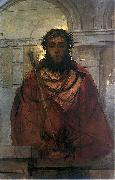 |
Albert Chmielowski
|
|
(born Adam Hilary Bernard Chmielowski; 1845 - 1916) was a Polish religious brother and founder of the Albertines. He is a saint of the Catholic Church. Albert is also known as Brat Albert (Brother Albert); in recognition of his holiness, he has also been called the "Brother of Our Lord", "Brother of Our God", and "Our God's Brother".
Adam Chmielowski was born to a wealthy aristocratic family, and initially studied agriculture with the intention of managing the family estate. Involved in politics since his youth, he lost a leg at the age of 17 while fighting in an insurrection. He became a well-known and well-liked artist in Krakew, his political convictions inspiring his interest in the human condition. A gentle and compassionate spirit, Chmielowski felt compelled to help those in need and after years of reflection, decided to follow his calling into the service of God.
In 1880, Chmielowski joined the Jesuits, took up the name Albert and abandoned painting. He began a life of service to the poor. In 1887, he founded the Brothers of the Third Order of Saint Francis, Servants of the Poor, known in honor of their founder as the Albertines or the Gray Brothers, after their rough gray habits. In 1891, he founded the women's congregation, the Gray Sisters. The Albertines organized food and shelter for the poor and homeless.
Albert believed that the great calamity of our time is that so many refuse to see and relieve the suffering of others. The so-called "haves" live away from the "have-nots", ignoring them and leaving their care to society.
|
|
|
|
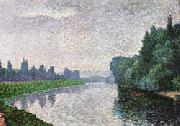 |
Albert Dubois-Pillet
|
|
French, 1846-1890.was a French painter and army officer. He graduated from the École Imp??riale Militaire at Saint-Cyr in 1867. He fought the Franco-Prussian War, during which he was made prisoner by the Germans. He started painting after the war, inspired by the Neoimpressionists. |
|
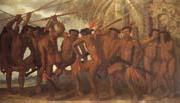 |
Albert Eckhout
|
|
Groningen, 1610 - 1666,was a Dutch portrait and still life painter. Eckhout was among the first European artists to paint scenes from the New World. In 1636, he traveled to Dutch Brazil, invited by count John Maurice, Prince of Nassau-Siegen. There, he painted portraits of natives, slaves and mulattos. He is also famous for his still lifes of Brazilian fruits and vegetables. The majority of his work is now stored at the National Museum of Denmark in Copenhagen. In art history, he is taken to be part of Baroque. |
|
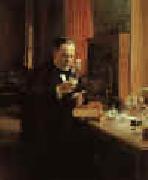 |
Albert Edelfelt
|
|
1854-1905
Finnish
Albert Edelfelt Location
Finnish painter, illustrator and etcher. He was Finland leading artist in the late 19th century, introducing French influences into Finnish art but also helping to gain a broader international interest in his country culture. He was not a great innovator, however, and although his reputation in Finland remained firm, international recognition dwindled after his death until the renewal of interest in realism that took place in the late 20th century. |
|
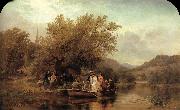 |
Albert Fitch Bellows
|
|
Nov.29.1829-Nov.24.1883, American landscape painter of the Hudson River School, was born at Milford, Massachusetts. He first studied architecture and opened his own architectural firm in 1849, but quickly turned to painting. From 1850 to 1856 he taught at the New England School of Design in Boston. He resigned his post to travel and study abroad, and spent time in Paris and at the Royal Academy at Antwerp as well as in England. He exhibited his first work at the National Academy of Design in 1857, becoming a full member in 1861, and he settled in New York City in 1858 on his return to America. Bellows spent most of his remaining career in New York, though he briefly moved to Boston. He visited Europe again in 1867. In New York he kept a studio in the same building as many of the notable Hudson River School artists of the time. His landscape work of the 1860s is fully in the late Hudson River School tradition, though Bellows depicted people more prominently in his landscapes than most other artists. He excelled at figurative scenes. Bellows also differed from most Hudson River School artists in that he became skilled at watercolor, and authored a respected book on the subject titled "Water-Color Painting: Some Facts and Authorities in Relation to Its Durability". He eventually maintained two studios, one for oil paintings and one for watercolor. He was a member of the American Watercolor Society, and an honorary member of the Royal Belgian Society of Water-Colorists. Bellows also mastered etching??along with Samuel Colman he was possibly the only other Hudson River School artist to do so??and became a member of the New York Etching Club, the Philadelphia Society of Etchers and the Royal Society of Painter-Etchers and Engravers in London, England, an esteemed professional organization whose members included James McNeil Whistler and Francis Seymour Haden. He died in Auburndale, |
|
|

